Genetic Characterization of Natural Oil Seeps in the Carpathians and Their Relationship to the Tectonic Structure
Abstract
1. Introduction
- The source type (type of organic matter);
- The age of the source substance (if age biomarkers are present);
- The maturity level of the source organic matter;
- Primary (from source rock to deposit—expulsion) and secondary (from basement to trap) migration paths.
1.1. The Classification of Seeps
1.2. Study Area
2. Materials and Methods
2.1. Samples
2.2. Sample Preparation
2.3. Group Separation (SARA)
2.4. GC-MS Analysis
- –
- Initial temperature 60 °C (isothermal—1 min);
- –
- Temperature increase at 4 °C per min to 310 °C;
- –
- Final temperature 310 °C (isothermal—15 min).
2.5. Isotopic Analysis
3. Results
3.1. SARA and Isotopic Composition
3.2. Molecular Composition
| Number | Pr/Ph | Oleanane/ C30hop | Ts/Tm | BNH/C30hop | C29NH/C30hop | C31 S/(S + R) | M/C30hop | Hop/Ster | S/(S + R) C29αα (Sterane) | ββ/(αα+ ββ)C29ster | Steranes [%] | MPI-1 | Rc1(MPI) | MDR | Rc2(MDR) | ||
|---|---|---|---|---|---|---|---|---|---|---|---|---|---|---|---|---|---|
| 27 | 28 | 29 | |||||||||||||||
| Silesian Unit | |||||||||||||||||
| 1 | 2.10 | 0.31 | 2.23 | N/A | 0.35 | ||||||||||||
| 2 | N/A | 0.18 | 1.77 | N/A | 0.35 | 0.58 | 0.12 | 3.39 | 0.50 | 0.55 | 38 | 26 | 36 | 0.57 | 0.74 | 2.07 | 0.66 |
| 3 | N/A | 0.23 | 1.65 | N/A | 0.32 | 0.59 | 0.13 | 3.21 | 0.57 | 0.43 | 55 | 19 | 26 | 0.61 | 0.76 | N/A | N/A |
| 4 | 1.23 | 0.19 | 2.18 | N/A | 0.28 | 0.54 | 0.12 | 2.47 | 0.51 | 0.40 | 37 | 28 | 35 | 0.51 | 0.71 | N/A | N/A |
| 5 | 1.42 | 0.23 | 2.10 | N/A | 0.27 | 0.57 | 0.13 | 2.60 | 0.52 | 0.46 | 34 | 32 | 34 | 0.51 | 0.71 | N/A | N/A |
| 6 | 2.15 | 0.27 | 1.39 | N/A | 0.39 | 0.58 | 0.14 | 2.45 | 0.49 | 0.43 | 37 | 30 | 33 | N/A | N/A | N/A | N/A |
| 7 | 2.35 | 0.23 | 1.06 | 0.10 | 0.35 | 0.57 | 0.15 | 2.42 | 0.56 | 0.45 | 30 | 36 | 34 | N/A | N/A | 6.46 | 0.98 |
| 8 | 2.30 | 0.30 | 1.15 | 0.09 | 0.36 | 0.26 | 0.15 | 2.46 | 0.53 | 0.46 | 29 | 31 | 40 | N/A | N/A | 6.46 | 0.98 |
| 9 | N/A | 0.19 | 1.86 | N/A | 0.31 | 0.56 | 0.11 | 3.39 | 0.49 | 0.42 | 37 | 28 | 35 | 0.50 | 0.70 | 1.90 | 0.65 |
| 10 | N/A | 0.20 | 1.89 | N/A | 0.28 | 0.57 | 0.12 | 3.51 | 0.52 | 0.44 | 33 | 29 | 38 | 0.49 | 0.70 | 0.99 | 0.58 |
| 11 | N/A | 0.18 | 1.54 | 0.05 | 0.36 | 0.58 | 0.12 | 3.00 | 0.49 | 0.47 | 21 | 33 | 46 | N/A | N/A | 2.77 | 0.71 |
| 12 | 1.88 | 0.16 | 1.95 | N/A | 0.34 | 0.56 | 0.12 | 2.95 | 0.47 | 0.58 | 36 | 28 | 36 | 0.74 | 0.85 | 1.77 | 0.64 |
| 13 | 1.88 | 0.21 | 0.99 | 0.07 | 0.36 | 0.56 | 0.15 | 3.10 | 0.46 | 0.41 | 23 | 31 | 46 | 0.49 | 0.70 | 1.73 | 0.63 |
| 14 | 2.06 | 0.22 | 0.97 | 0.07 | 0.39 | 0.56 | 0.14 | 2.14 | 0.38 | 0.33 | 32 | 29 | 39 | N/A | N/A | 1.88 | 0.65 |
| Skole Unit | |||||||||||||||||
| 15 | 2.00 | 0.17 | 0.61 | 0.03 | 0.49 | 0.57 | 0.11 | 2.67 | 0.56 | 0.53 | 30 | 39 | 31 | N/A | N/A | 2.48 | 0.69 |
| 16 | 1.89 | 0.17 | 0.82 | 0.29 | 0.33 | 0.60 | 0.11 | 2.55 | 0.28 | 0.38 | 29 | 36 | 35 | 0.56 | 0.73 | 7.87 | 1.08 |
| 17 | 2.26 | 0.17 | 1.13 | 0.46 | 0.40 | 0.55 | 0.12 | 1.83 | 0.31 | 0.44 | 27 | 37 | 36 | 0.40 | 0.64 | 3.33 | 0.75 |
| 18 | N/A | 0.19 | 0.48 | 0.47 | 0.43 | 0.57 | 0.15 | N/A | 0.35 | 0.43 | 27 | 36 | 37 | N/A | N/A | N/A | N/A |
| Magura Unit | |||||||||||||||||
| 19 | 1.72 | 0.26 | 0.72 | 0.30 | 0.52 | 0.54 | 0.15 | 0.37 | 0.39 | 0.37 | 27 | 38 | 35 | N/A | N/A | 2.49 | 0.69 |
| 20 | 1.82 | 0.16 | 1.06 | 0.06 | 0.44 | 0.58 | 0.12 | 0.39 | 0.32 | 0.39 | 28 | 30 | 42 | N/A | N/A | N/A | N/A |
| 21 | 1.69 | 0.18 | 1.30 | N/A | 0.34 | 0.59 | 0.10 | 2.49 | 0.53 | 0.42 | 28 | 35 | 37 | 0.75 | 0.85 | 3.90 | 0.79 |
| 22 | N/A | 0.18 | 1.69 | 0.04 | 0.38 | 0.58 | 0.14 | 2.98 | 0.42 | 0.42 | 31 | 36 | 33 | 0.76 | 0.86 | 4.95 | 0.87 |
| 23 | N/A | 0.14 | 1.80 | 0.01 | 0.38 | 0.58 | 0.13 | 2.87 | 0.48 | 0.48 | 29 | 39 | 32 | 0.61 | 0.76 | 3.93 | 0.80 |
| 24 | N/A | 0.13 | 1.65 | N/A | 0.32 | 0.58 | 0.12 | 0.45 | 0.47 | 0.45 | 30 | 30 | 40 | 0.76 | 0.86 | 4.15 | 0.81 |
| 25 | N/A | 0.13 | 1.58 | N/A | 0.37 | 0.54 | 0.13 | 0.46 | 0.48 | 0.46 | 30 | 31 | 39 | 0.74 | 0.85 | 3.90 | 0.79 |
| 26 | 1.42 | 0.15 | 1.93 | N/A | 0.31 | 0.58 | 0.14 | 0.43 | 0.45 | 0.43 | 25 | 32 | 43 | 0.76 | 0.85 | 4.53 | 0.84 |
4. Discussion
5. Conclusions
- The first type includes seepages from the Skole unit, originating from the source material of the Menilite Beds, where C29 and C28 steranes dominate, suggesting the presence of terrestrial and algal material deposited in an oxic and suboxic environment in the presence of sulphide waters (correlation with oils in the Łodyna Wańkowa fold).
- The second type consists of seeps from the Magura unit, which is isotopically the lightest and has a higher share of marine material with a low bacterial content, similar to the Menilites from the Dukla unit. These are seeps with a high thermal maturity index.
- The third type includes seeps from the Silesian unit, with a higher proportion of terrestrial material deposited in a suboxic or oxic environment in the deeper part of the basin, without the presence of bisnorhopane, but with a predominance of prokaryotes over eukaryotes. The nature of these seeps is more diverse, which may indicate an additional, different source of supply than the Menilite Beds. They can be locally associated with oils in the Potok, Grabownica folds, or the Czarna deposit.
- The most characteristic seep is Bandrów (type 2) in the Skole unit. It is the only seep that can be described as “flowing”.
- According to this classification, the fourth type of seep can be attributed to seeps from Ropianka in the Magura unit, where seep surfaces are located at outcrops of tectonic discontinuities.
Author Contributions
Funding
Data Availability Statement
Acknowledgments
Conflicts of Interest
References
- Abrams, M.A. Significance of hydrocarbon seepage relative to petroleum generation and entrapment. Mar. Pet. Geol. 2005, 22, 457–477. [Google Scholar] [CrossRef]
- Logan, G.A.; Jones, A.T.; Kennard, J.M.; Ryan, G.J.; Rollet, N. Australian offshore natural hydrocarbon seepage studies, a review and re-evaluation. Mar. Pet. Geol. 2010, 27, 26–45. [Google Scholar] [CrossRef]
- Galarraga, F.; Urbani, F.; Escobar, M.; Márquez, G.; Martínez, M.; Tocco, R. Main factors controlling the compositional variability of seepage oils from Trujillo state, Western Venezuela. J. Pet. Geol. 2010, 3, 255–268. [Google Scholar] [CrossRef]
- Ionescu, A.; Burrato, P.; Baciu, C.; Etiope, G.; Kis, B.M. Inventory of Onshore Hydrocarbon Seeps in Romania (HYSED-RO Database). Geosciences 2017, 7, 39. [Google Scholar] [CrossRef]
- Alzaga-Ruiz, H.; Lopez, M.; Roure, F.; Seranne, M. Interactions between the Laramide Foreland and the passive margin of the Gulf of Mexico: Tectonics and sedimentation in the Golden Lane area, Veracruz State, Mexico. Mar. Pet. Geol. 2009, 26, 951–973. [Google Scholar] [CrossRef]
- Clarke, R.; Cleverly, R. Petroleum seepage and post-accumulation migration. Geol. Environ. Sci. Geol. Soc. Lond. Spec. Publ. 1991, 59, 265–271. [Google Scholar] [CrossRef]
- Link, W.K. Significance of oil and gas seeps in world oil exploration. Bull. AAPG 1952, 36, 1505–1540. [Google Scholar]
- Duncan, S. Macgregor. Relationships between seepage, tectonics and subsurface petroleum reserves. Mar. Pet. Geol. 1993, 10, 606–619. [Google Scholar]
- Piggott, N.; Abrams, M.A. Near surface coring in the Beaufort and Chukchi Seas. In Hydrocarbon Migration and Its Near Surface Effects; Schumacher, D., Abrams, M.A., Eds.; American Association of Petroleum Geologist Memoir: Tulsa, OK, USA, 1996; Volume 66, pp. 385–400. [Google Scholar]
- Tocco, R.; Escobar, M.; Ruggiero, A.; Galarraga, F. Geochemistry of oil seeps and rock samples of the Early Tertiary section from the North Andean of the Venezuelan Andes. Org. Geochem. 1995, 23, 311–327. [Google Scholar] [CrossRef]
- Heggland, R. Gas seepage as an indicator of deeper prospective reservoirs. A study based on exploration 3-D seismic data. Mar. Pet. Geol. 1998, 15, 1–9. [Google Scholar] [CrossRef]
- Kuśmierek, J. Ewolucja a ropogazonośność Karpat polskich. Pr. Geol. PAN 1995, 138, 190. [Google Scholar]
- Ślączka, A. Stratygrafia serii śląskiej łuski Bystrego na południe od Baligrodu. Biul. Inst. Geol. 1959, 131, 251–286. [Google Scholar]
- Konarski, E. Wgłębna Budowa Karpackiej Pokrywy Fliszowej w Rejonie Gorlicko-Krośnieńskim; Wydawnictwa Geologiczne: Warsaw, Poland, 1980. [Google Scholar]
- Żytko, K.; Gucik, S.; Ślączka, A. Przewodnik Geologiczny po Wschodnich Karpatach Fliszowych; Wydawnictwa Geologiczne: Warsaw, Poland, 1973. [Google Scholar]
- Kuśmierek, J.; Semyrka, R. Zmienność cech zbiornikowych przestrzeni porowo-szczelinowej piaskowców karpackich i ich kwalifikacja naftowa. Przegląd Geol. 2003, 9, 51. [Google Scholar]
- Peters, K.E.; Walters, C.C.; Moldowan, J.M. The biomarker guide. In Biomarkers and Isotopes in Petroleum Exploration and Earth History, 2nd ed.; Cambridge University Press: Cambridge, UK, 2005. [Google Scholar]
- England, W.A.; Mackenzie, A.S.; Mann, D.M.; Quigley, T.M. The movement and entrapment of petroleum fluids in the subsurface. J. Geol. Soc. 1987, 144, 327–347. [Google Scholar] [CrossRef]
- Masterson, W.D.; Dzou, L.I.P.; Holba, A.G.; Fincannon, A.L.; Ellis, L. Evidence for biodegradation and evaporative fractionation in West Sak, Kuparuk and Prudhoe Bay field areas, North Slope, Alaska. Org. Geochem. 2001, 32, 411–441. [Google Scholar] [CrossRef]
- Więcław, D.; Bilkiewicz, E.; Kotarba, M.J.; Lillis, P.G.; Dziadzio, P.S.; Kowalski, A.; Kmiecik, N.; Romanowski, T.; Jurek, K. Origin and secondary processes in petroleum in the eastern part of the Polish Outer Carpathians. Int. J. Earth Sci. 2020, 109, 63–99. [Google Scholar] [CrossRef]
- Karnkowski, P. Złoża gazu ziemnego i ropy naftowej w Polsce. T. 2. In Karpaty i Zapadlisko Przedkarpackie; Towarzystwo Geosynoptyków Geos AGH: Kraków, Poland, 1993. [Google Scholar]
- Karnkowski, P.; Konarski, E. Katalog złóż ropy naftowej i gazu ziemnego w Polsce. In Karpaty; Wydawnictwa Geologiczne: Warsaw, Poland, 1973. [Google Scholar]
- Kotarba, M.J.; Koltun, Y.V. The origin and habitat of hydrocarbons of the Polish and Ukrainian Parts of the Carpathian Province. Am. Ass. Petrol. Geol. Mem. 2006, 84, 395–442. [Google Scholar]
- Zhang, J.; Cao, J.; Wang, Y.; Li, J.; Hu, G.; Zhou, N.; Shi, T. Geochemistry and Genesis of Oil and Gas Seeps in the Junggar Basin, NW China: Implications for Hybrid Petroleum Systems. Geofluids 2019, 2019, 1–26. [Google Scholar] [CrossRef]
- Liu, Y.; Wu, K.; Wang, X.; Liu, B.; Guo, J.; Du, Y. Architecture of buried reverse fault zone in the sedimentary basin: A case study from the Hong-Che fault zone of the Junggar Basin. J. Struct. Geol. 2017, 105, 1–17. [Google Scholar] [CrossRef]
- Mackenzie, A.S. Application of biological markers in petroleum geochemistry. Adv. Pet. Geochem. 1984, 1, 115–214. [Google Scholar]
- Matyasik, I. Biomarkery w Charakterystyce Genetycznej Systemów Naftowych; Prace INiG-PIB: Kraków, Poland, 2011; 220p, ISSN 0209-0724. nr 177. [Google Scholar]
- Palmer, S. Effect of water washing on C15+ hydrocarbon fraction of crude oils from northwest Palawan, Philippines. Am. Ass. Petrol. Geol. Bull. 1984, 68, 137–149. [Google Scholar]
- Moldowan, J.M.; Seifert, W.K.; Gallego, S.E.J. Relationship between petroleum composition and depositional environment of petroleum source rocks. Am. Ass. Petrol. Geol. Bull. 1985, 69, 1255–1268. [Google Scholar]
- Palmer, S.E. Effect of biodegradation and water washing on crude oil composition. In Organic Geochemistry; Engel, M.H., Macko, S.A., Eds.; Plenum Press: New York, NY, USA, 1993; pp. 511–533. [Google Scholar]
- Peters, K.E.; Moldowan, J.M. Effects of source, thermal maturity, and biodegradation on the distribution and isomerization of homohopanes in petroleum. Org. Geochem. 1991, 17, 47–61. [Google Scholar] [CrossRef]
- Didyk, B.M.; Simoneit, B.R.T.; Brassell, S.C.; Eglinton, G. Organic geochemical indicators of palaeoenvironmental conditions of sedimentation. Nature 1978, 272, 216–222. [Google Scholar] [CrossRef]
- Kruge, M.A.; Mastalerz, M.; Solecki, A.; Stankiewicz, B.A. Organic geochemistry and petrology of oil source rocks, Carpathian Overthrust region, southeastern Poland—Implications for petroleum generation. Org. Geochem. 1996, 24, 897–912. [Google Scholar] [CrossRef]
- Köster, J.; Kotarba, M.; Lafargue, E.; Kosakowski, P. Source rock habitat and hydrocarbon potential of Oligocene Menilite Formation (Flysch Carpathians, Southeast Poland): An organic geochemical and isotope approach. Org. Geochem. 1998, 29, 543–558. [Google Scholar] [CrossRef]
- Curiale, J.A.; Odermatt, J.R. Short-term biomarker variability in the Monterey Formation, Santa Maria Basin. Org. Geochem. 1988, 14, 1–13. [Google Scholar] [CrossRef]
- Curiale, J.A.; Bromley, B.W. Migration of petroleum into Vermilion field, Gulf Coast, USA-Molecular evidence. Org. Geochem. 1996, 24, 563–579. [Google Scholar] [CrossRef]
- Dahl, B. The use of bisnorhopane as a stratigraphic marker in the Oseberg Back Basin, North Viking Graben, Norwegian North Sea. Org. Geochem. 2004, 35, 1551–1571. [Google Scholar] [CrossRef]
- Killops, S.D.; Massoud, M.S.; Scott, A.C. Biomarker characterization of an oil and its possible source rock from offshore Korea Bay Basin. Appl. Geochem. 1991, 6, 143–157. [Google Scholar] [CrossRef]
- Peters, K.E.; Moldowan, J.M. The Biomarker Guide: Interpreting Molecular Fossils in Petroleum and Ancient Sediments; Prentice-Hall: Englewood Cliffs, NJ, USA, 1993. [Google Scholar]
- Radke, M. Application of aromatic compounds as maturity indicators in source rocks and crude oils. Mar. Petrol. Geol. 1988, 5, 224–236. [Google Scholar] [CrossRef]
- Czochanska, Z.; Gilbert, T.D.; Philp, R.P.; Sheppard, C.M.; Weston, R.J.; Wood, A.D.; Woolhouse, A.D. Geochemical application of sterane and triterpane biomarkers to a description of oils from the Taranaki Basin in New Zealand. Org. Geochem. 1988, 12, 123–135. [Google Scholar] [CrossRef]
- Borys, Z. Aktualne problemy poszukiwań węglowodorów we wschodniej części przedgórza Karpat. Przeg. Geol. 1996, 44, 1019–1023. [Google Scholar]
- Curtis, J.B.; Kotarba, M.J.; Lewan, M.D.; Więcław, D. Oil/source rock correlations in the Polish Flysch Carpathians and Mesozoic basement and organic facies of the Oligocene Menilite Shales: Insights from hydrous pyrolysis experiments. Org. Geochem. 2004, 35, 1573–1596. [Google Scholar] [CrossRef]
- Koltun, Y.V. Organic matter in Oligocene Menilite Formation rocks of the Ukrainian Carpathians: Palaeoenvironment and geochemical evolution. Org. Geochem. 1992, 18, 423–430. [Google Scholar] [CrossRef]
- Bieleń, W.; Janiga, M. Zastosowanie badań izotopowych do określania pochodzenia wybranych biomarkerów. Naft. Gaz. 2022, 5, 336–342. [Google Scholar] [CrossRef]
- Sofer, Z. Stable carbon isotopic compositions of crude oils: Application of the source depositional environments and petroleum alteration. Am. Ass. Petrol. Geol. Bull. 1984, 68, 31–49. [Google Scholar]
- Dziadzio, P.; Jankowski, L.; Kopciowski, R.; Maksym, A.; Matyasik, I. Geologia jednostki śląskiej (wybrane elementy—Potencjalnej strefy do przyszłych poszukiwań naftowych. Elementy systemu naftowego od skały macierzystej do pułapki—Wybrane przykłady z obrębu jednostki śląskiej. In Materiały Konferencyjne LXXV Zjazdu Naukowego PTG; Dziadzio, P., Uchman, A., Eds.; Państwowy Instytut Geologiczny: Jasło, Kraków, Poland, 2004; pp. 153–162. ISBN 83-7372-740-X. [Google Scholar]
- Moldowan, J.M.; Fago, F.J.; Huizinga, B.J.; Jacobson, S.R. Analysis of oleanane and its occurrence in Upper Cretaceous rocks. In Organic Geochemistry. Advances and Applications in Energy and the Natural Environment (15th Meeting of European Association of Organic Geochemists Poster Abstracts); Manning, D.A.C., Ed.; Manchester University Press: Manchester, UK, 1991; pp. 195–197. [Google Scholar]
- Moldowan, M.; Dahl, J.; Huiznga, B.; Fago, F.; Hickey, L.; Peakman, T.; Taylor, D. The molecular fossil record of oleanane and its relation to angiosperms. Science 1994, 256, 768–771. [Google Scholar]
- Murray, A.P.; Sosrowidjojo, I.B.; Alexander, R.; Kagi, R.I.; Norgate, C.M.; Summons, R.E. Oleananes in oils and sediments: Evidences of marine influence during early diagenesis. Geochim. Cosmochim. Acta 1997, 61, 1261–1276. [Google Scholar] [CrossRef]
- Alberdi, M.; Lopez, L. Biomarker 18a(H)-oleanane: A geochemical tool to assess Venezuelan petroleum systems. J. S. Am. Earth Sci. 2000, 13, 751–759. [Google Scholar] [CrossRef]
- Bieleń, W. Związki arylowoizoprenoidowe jako wskaźniki charakteru środowiska sedymentacji. Naft. Gaz 2019, 9, 546. [Google Scholar] [CrossRef]
- Bieleń, W.; Janiga, M. Spektrometria masowa i analiza izotopowa biomarkerów frakcji nasyconej. Naft. Gaz 2021, 77, 512–520. [Google Scholar] [CrossRef]
- Summons, R.E.; Powell, T.G. Identification of aryl isoprenoids in source rocks and crude oils: Biological markers for the green sulphur bacteria. Geoch. Cosmochim. Acta 1987, 51, 557–566. [Google Scholar] [CrossRef]
- Dziadzio, P.S.; Matyasik, I. Sedimentological and geochemical characterisation of the Lower Oligocene Menilite shales from the Magura, Dukla, and Silesian nappes, Polish Outer Carpathians—A new concept. Mar. Pet. Geol. 2021, 132, 105–247. [Google Scholar] [CrossRef]

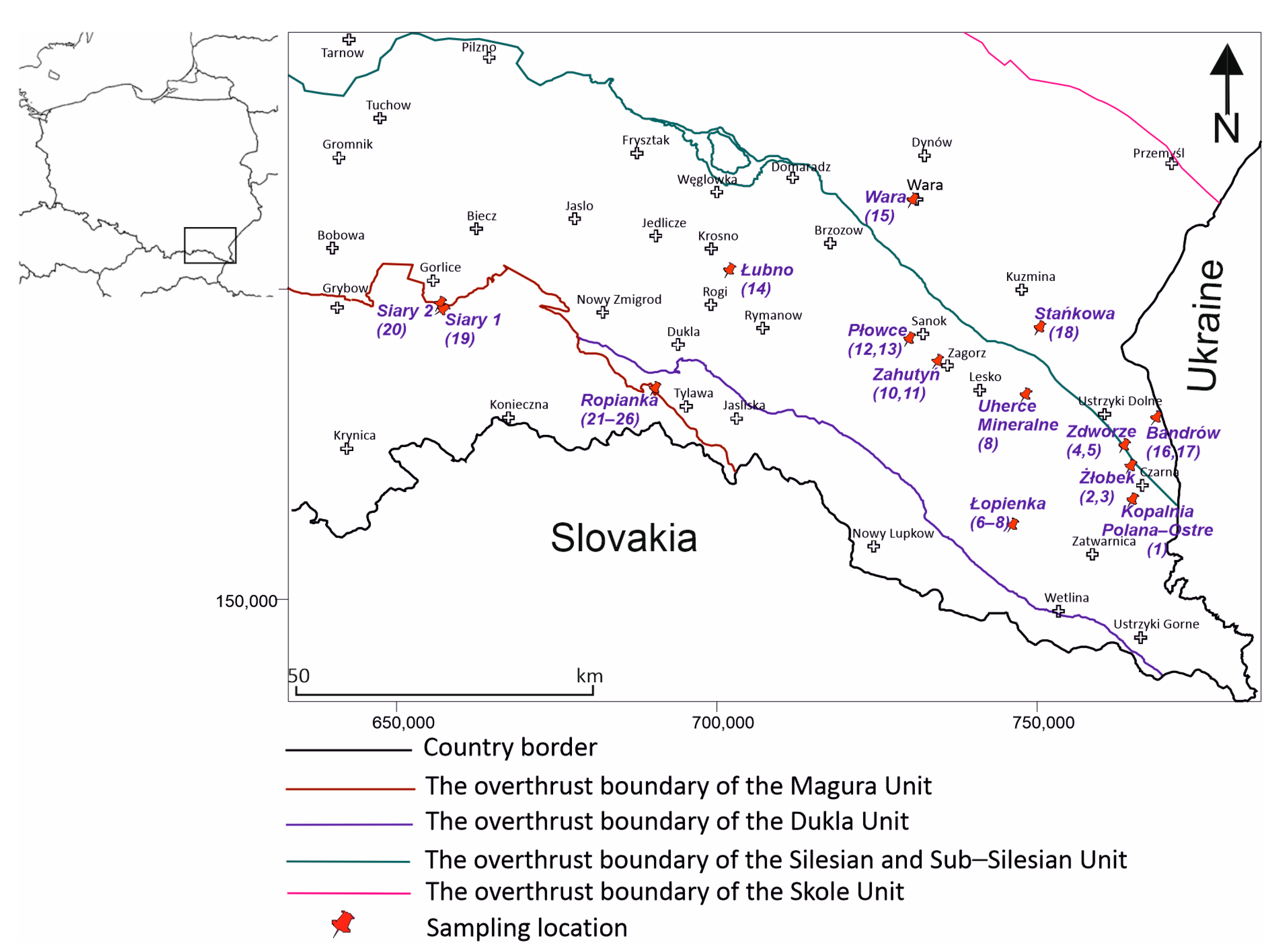



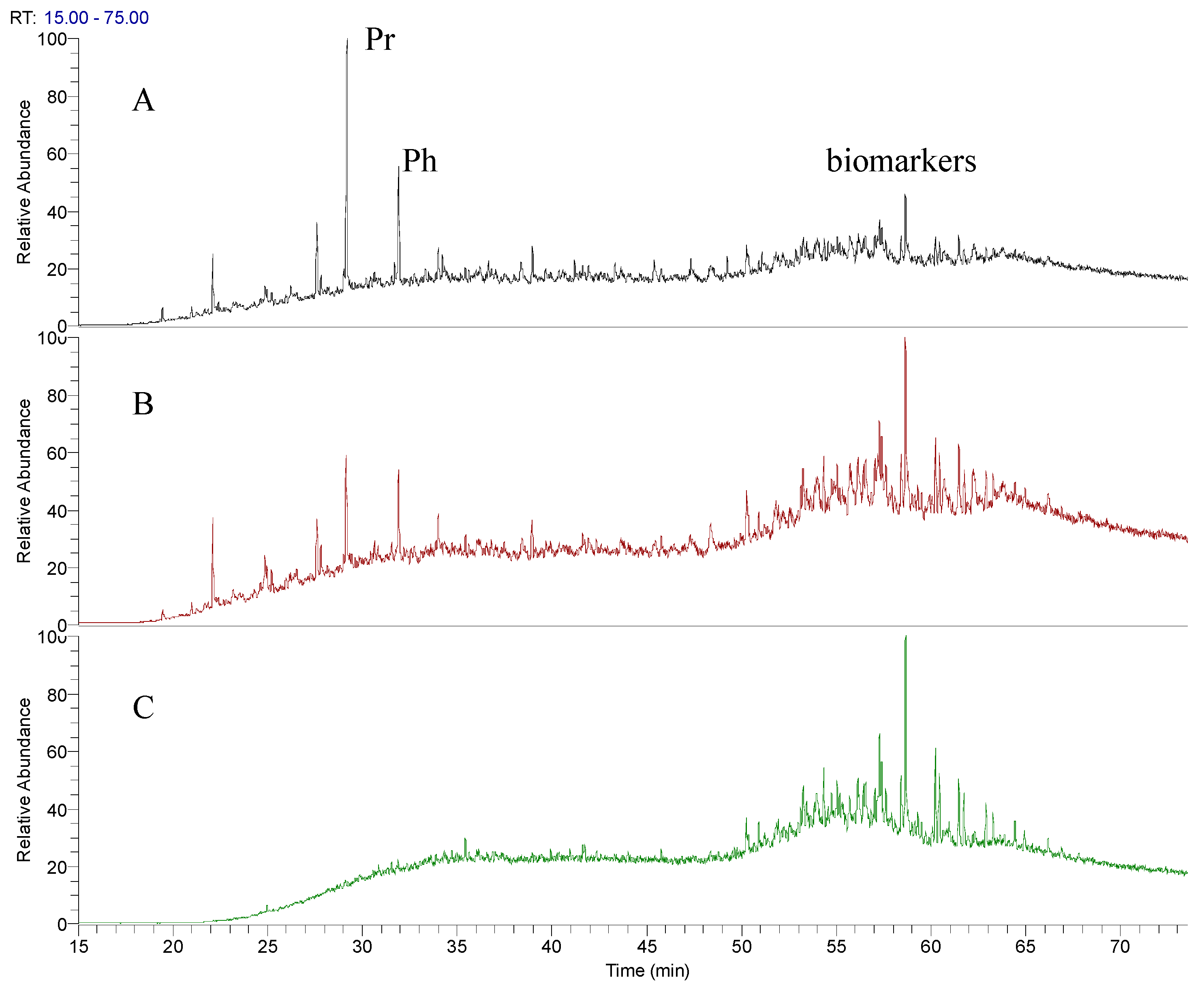



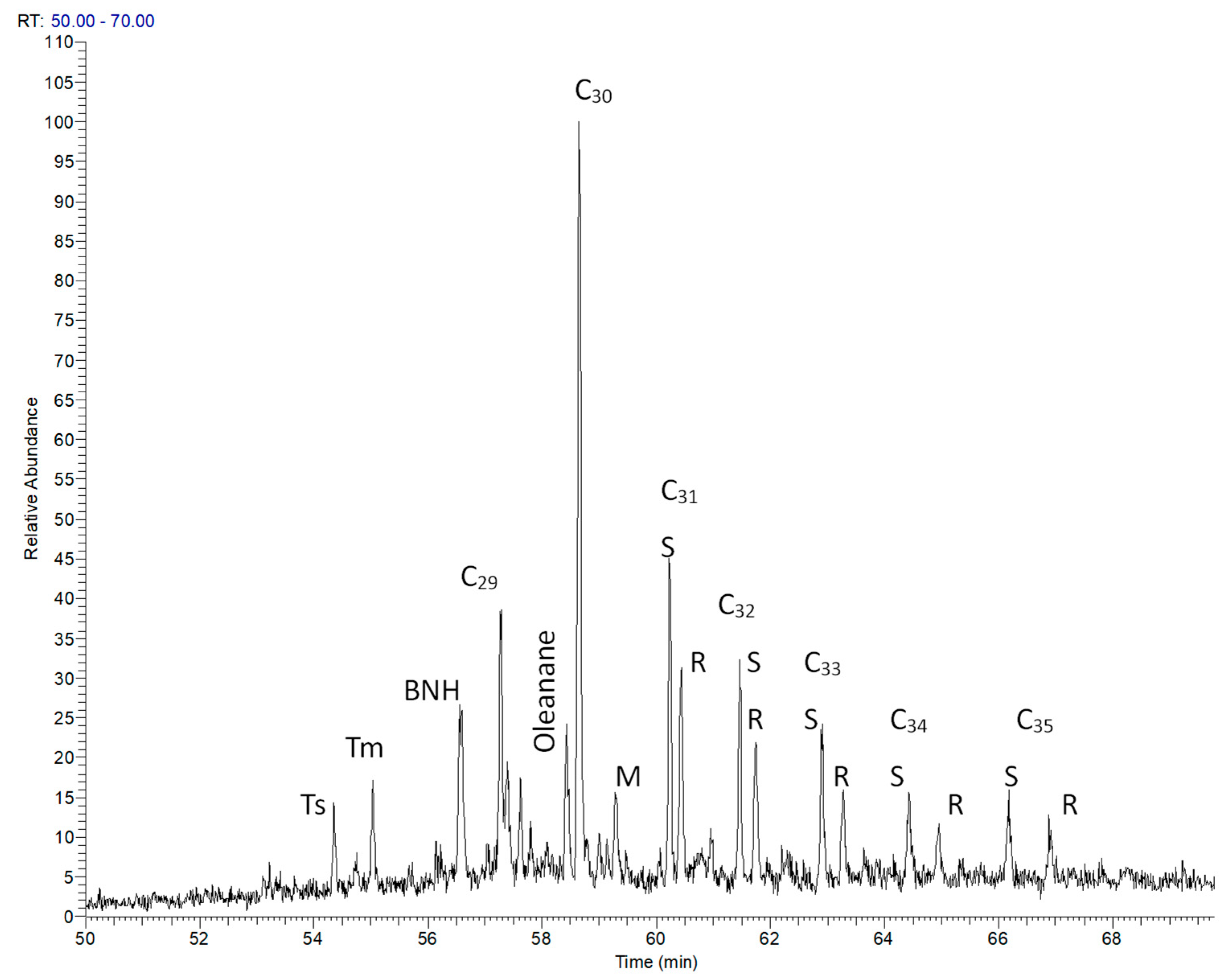
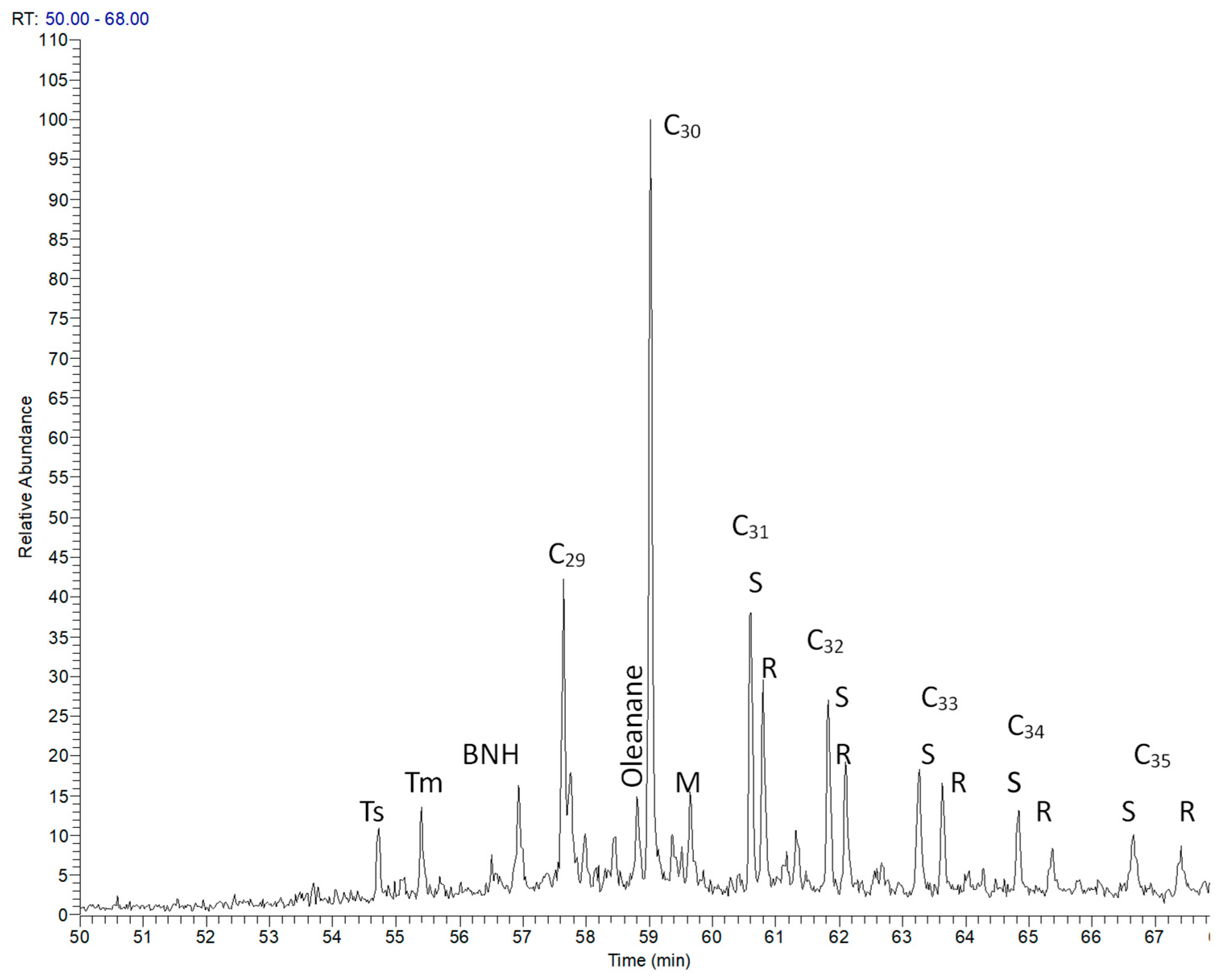


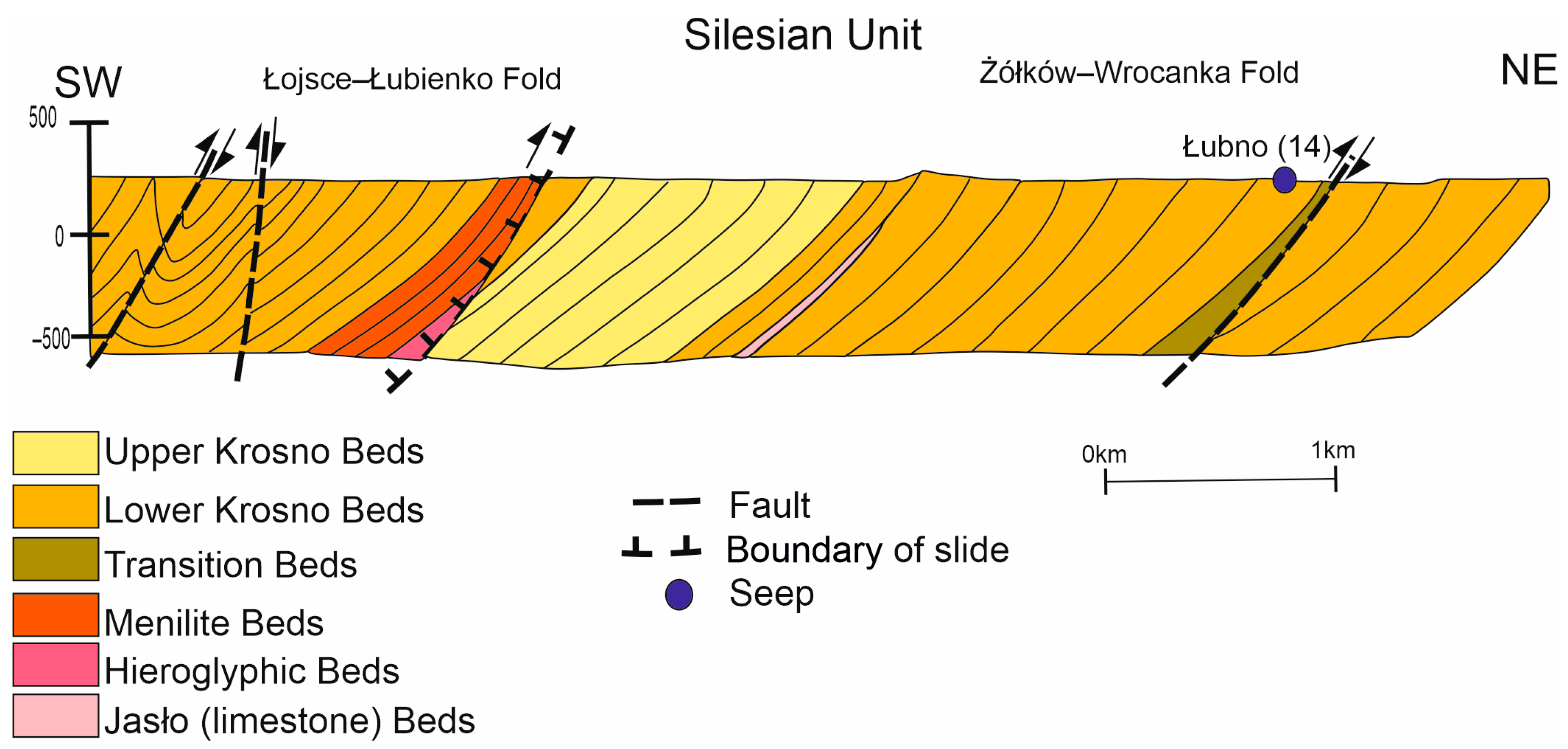


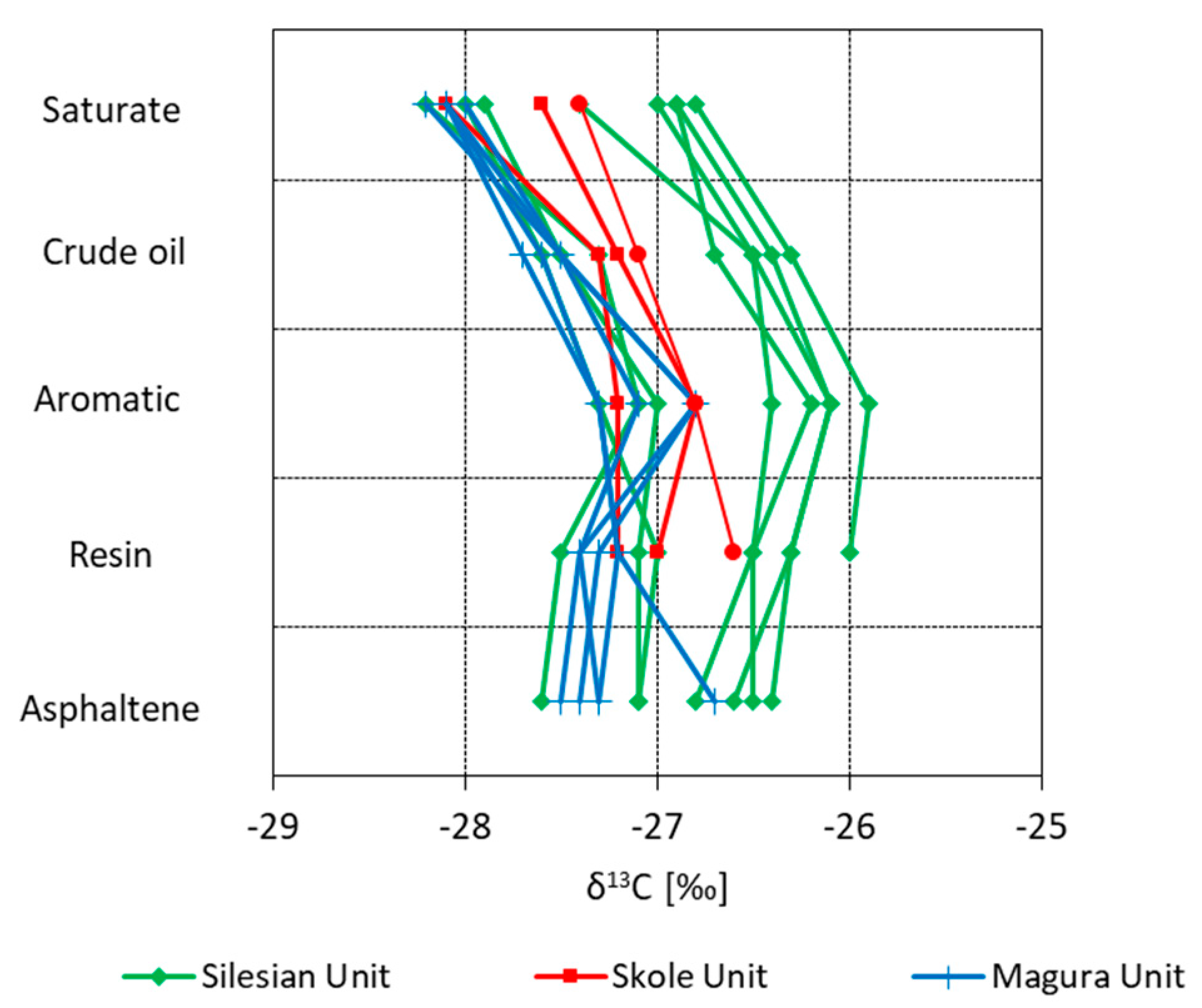



| Number | Formation | SARA Separation [%] | Ratio SA/SARA | Sulfur Content [%] | Carbon Isotopic Composition | |||||||
|---|---|---|---|---|---|---|---|---|---|---|---|---|
| Saturates | Aromatics | Resins | Asphaltenes | SAT | SEEP | AROM | RES | ASPH | ||||
| Silesian Unit | ||||||||||||
| 1 | Krosno | 66.78 | 18.83 | 12.51 | 1.90 | 0.86 | 0.00 | −26.80 | −26.30 | −25.90 | −26.00 | N/A |
| 2 | Krosno | 50.96 | 23.90 | 22.36 | 2.80 | 0.74 | 0.16 | −26.90 | −26.40 | −26.10 | −26.30 | −26.60 |
| 3 | Krosno | 45.06 | 27.21 | 24.23 | 3.50 | 0.72 | 0.09 | N/A | N/A | N/A | N/A | N/A |
| 4 | Krosno | 42.97 | 18.65 | 16.21 | 22.20 | 0.62 | 0.16 | −27.00 | −26.50 | −26.10 | −26.30 | −26.40 |
| 5 | Krosno | 52.27 | 24.45 | 20.65 | 2.60 | 0.77 | 0.12 | N/A | N/A | N/A | N/A | N/A |
| 6 | Krosno | 60.42 | 22.31 | 15.71 | 1.60 | 0.82 | 0.23 | −27.90 | −27.50 | −27.00 | −27.10 | −27.10 |
| 7 | Krosno | 70.30 | 17.70 | 10.90 | 1.10 | 0.88 | 0.23 | N/A | N/A | N/A | N/A | N/A |
| 8 | Krosno | 62.20 | 22.50 | 14.10 | 1.20 | 0.85 | N/A | N/A | N/A | N/A | N/A | N/A |
| 9 | Krosno | 45.03 | 24.54 | 26.27 | 4.16 | 0.69 | 0.23 | −27.40 | −26.50 | −26.40 | −26.50 | −26.50 |
| 10 | Krosno | 39.64 | 24.52 | 27.66 | 8.17 | 0.64 | 0.21 | −26.90 | −26.70 | −26.20 | −26.50 | −26.80 |
| 11 | Krosno | 39.10 | 37.80 | 14.90 | 8.20 | 0.77 | N/A | N/A | N/A | N/A | N/A | N/A |
| 12 | Krosno | 54.57 | 23.89 | 19.44 | 2.11 | 0.78 | 0.26 | −28.20 | −27.30 | −27.10 | −27.50 | −27.60 |
| 13 | Krosno | N/A | N/A | N/A | N/A | N/A | N/A | N/A | N/A | N/A | N/A | N/A |
| 14 | Krosno | 53.10 | 30.20 | 14.10 | 2.60 | 0.83 | N/A | −28.00 | −27.60 | −27.30 | −27.00 | −27.10 |
| Skole Unit | ||||||||||||
| 15 | Inoceramian | 48.10 | 35.20 | 14.70 | 2.00 | 0.83 | N/A | −27.40 | −27.10 | −26.80 | −26.60 | N/A |
| 16 | Kliwa sands | 54.62 | 23.41 | 20.55 | 1.40 | 0.77 | 0.37 | −27.60 | −27.20 | −26.80 | −27.00 | N/A |
| 17 | Kliwa sands | N/A | N/A | N/A | N/A | N/A | N/A | N/A | N/A | N/A | N/A | N/A |
| 18 | Menilite Beds | 19.40 | 54.70 | 23.20 | 2.70 | 0.74 | N/A | −28.10 | −27.30 | −27.20 | −27.20 | N/A |
| Magura Unit | ||||||||||||
| 19 | Inoceramian | 54.86 | 30.67 | 13.33 | 1.10 | 0.85 | N/A | −28.10 | −27.70 | −27.30 | −27.20 | −26.70 |
| 20 | Inoceramian | 70.54 | 13.70 | 14.60 | 1.20 | 0.84 | N/A | −28.10 | −27.60 | −27.30 | −27.20 | −27.30 |
| 21 | Inoceramian | 48.91 | 23.41 | 25.40 | 2.30 | 0.73 | 0.00 | N/A | N/A | N/A | N/A | N/A |
| 22 | Inoceramian | 48.10 | 35.20 | 14.70 | 2.00 | 0.86 | N/A | N/A | N/A | N/A | N/A | N/A |
| 23 | Inoceramian | 54.62 | 23.41 | 20.55 | 1.40 | 0.86 | N/A | N/A | N/A | N/A | N/A | N/A |
| 24 | Inoceramian | 50.80 | 28.28 | 15.10 | 5.80 | 0.79 | N/A | −28.20 | −27.50 | −26.80 | −27.30 | −27.40 |
| 25 | Inoceramian | 48.69 | 35.92 | 13.72 | 1.70 | 0.74 | N/A | −28.10 | −27.50 | −26.80 | −27.40 | −27.50 |
| 26 | Inoceramian | 56.51 | 26.77 | 14.92 | 1.80 | 0.83 | N/A | −28.00 | −27.50 | −27.10 | −27.40 | −27.30 |
Disclaimer/Publisher’s Note: The statements, opinions and data contained in all publications are solely those of the individual author(s) and contributor(s) and not of MDPI and/or the editor(s). MDPI and/or the editor(s) disclaim responsibility for any injury to people or property resulting from any ideas, methods, instructions or products referred to in the content. |
© 2025 by the authors. Licensee MDPI, Basel, Switzerland. This article is an open access article distributed under the terms and conditions of the Creative Commons Attribution (CC BY) license (https://creativecommons.org/licenses/by/4.0/).
Share and Cite
Bieleń, W.; Matyasik, I.; Janiga, M.; Wciślak-Oleszycka, A. Genetic Characterization of Natural Oil Seeps in the Carpathians and Their Relationship to the Tectonic Structure. Energies 2025, 18, 3575. https://doi.org/10.3390/en18133575
Bieleń W, Matyasik I, Janiga M, Wciślak-Oleszycka A. Genetic Characterization of Natural Oil Seeps in the Carpathians and Their Relationship to the Tectonic Structure. Energies. 2025; 18(13):3575. https://doi.org/10.3390/en18133575
Chicago/Turabian StyleBieleń, Wojciech, Irena Matyasik, Marek Janiga, and Agnieszka Wciślak-Oleszycka. 2025. "Genetic Characterization of Natural Oil Seeps in the Carpathians and Their Relationship to the Tectonic Structure" Energies 18, no. 13: 3575. https://doi.org/10.3390/en18133575
APA StyleBieleń, W., Matyasik, I., Janiga, M., & Wciślak-Oleszycka, A. (2025). Genetic Characterization of Natural Oil Seeps in the Carpathians and Their Relationship to the Tectonic Structure. Energies, 18(13), 3575. https://doi.org/10.3390/en18133575






